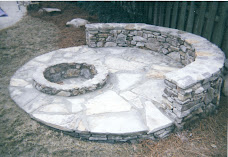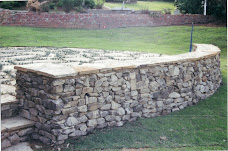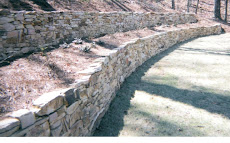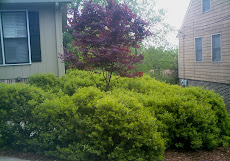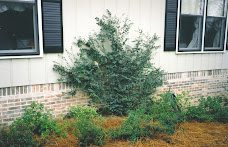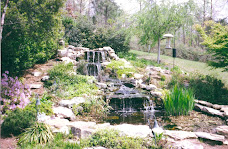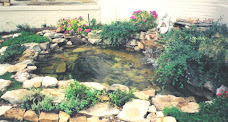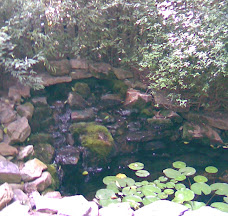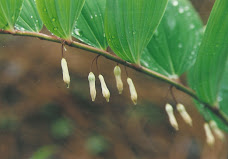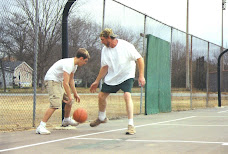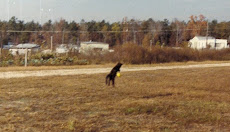
My most recent landscape excursion involved the installation of a front foundation planting in Hoover, AL. The home owners brought up a few concerns as we began talking about their landscape. For one, they had been battling some erosion issues at the sloping end of their home by the drive way. Also, there being issues with allergies in the family, plants for the landscape needed to be chosen to address those needs. Finally, the homeowners talked about wanting a landscape that wouldn’t become overwhelming for them. I was excited that they were aware that spacing plants too closely, while looking great initially, would eventually bring on pruning headaches and make the landscape seem like one giant hedge rather than a thoughtful gathering of distinguishable plants. PHOTO LEFT: Son, Jake, helps his dad with stone wall installation.
PHOTO LEFT: Son, Jake, helps his dad with stone wall installation.
A brown stone wall was installed to negate the sloping portion of the front foundation. The wall, about 4’ tall at the drive, flows into what becomes a stone border for the entire foundation planting. The wall and stone border follows lines that are curved to help include a couple of small trees and some plant depth within the planting area. Also, a small stone bench is placed on the level side of the foundation for interest and also to add a little extra “weight” to help counter the stone wall on the sloping side of the house.
Choosing plants that are relatively allergy free required a bit of research. I was aware that plants with leaves that are heavily pubescent would be more prone to trigger an allergic reaction, so that was my starting point as I developed a plant list. I also used the book, “Allergy-Free Gardening”, by Thomas Leo Ogren. Mr. Ogren uses a 1 to 10 rating system to classify a plant’s allergy potential. Every plant used in this landscape was rated 1 (best) to 5, with most being rated 3 or better. The plant list:
(from left to right as you look at the house from the street)
1. Variegated Pittosporum
2. Bloodgood Japanese maple
3. Autumn fern
4. Shi-Shi Gashira Camellia
5. Harbor Dwarf Nandina
6. Snow Indian Hawthorne
7. George Tabor Azalea
8. Tonto Crape Myrtle
9. Sherwood Abelia
10. Pansies (probably Begonias in the Spring)
Spacing of the plants in this landscape was generous. Aside from avoiding a crowded landscape in the future, a well spaced landscape also encourages good air circulation between plants which is very helpful in promoting good plant health. Another feature of this landscape was the installation of landscape cloth. Landscape cloth is similar to landscape fabric, but better. No cloth or fabric is 100 percent effective, but it can typically cut down on about 95%, or more, of your weed problems during the first 5+ years of the life of a landscape and that is when you really need that kind of weed control.
It was enjoyable working on this project...The weather was great, all aspects of the job were fun, and working for the home owners was really a pleasure.
Sunday, October 17, 2010
A Foundation Planting that is Mindful of Erosion, Allergies, and Spacing
Posted by
themanfromearth
at
10:29 PM
2
comments
![]()
Labels: bench seating, project showcases, stone work, walls
Friday, July 16, 2010
Fire on the Water: Fire Pit, Flagstone Patio and Sitting Wall on Lake Martin

A recent project sent me out near Pell City, Alabama, at the vacation home of some nice folks on Lake Martin. These snapshots were taken the day I finished the job. I'll add updates when some landscaping is done and a few pieces of furniture are added to the patio. Large patios, especially, benefit greatly with the addition of furniture, plantings, etc. 
I sure can imagine enjoying a nice, late fall evening, while sitting on a cushy lounge chair, sipping a favorite beverage, feeling the warmth of the fire and the coolness of the air as lake ripples sound off a relaxing melody! 
Posted by
themanfromearth
at
7:32 AM
1 comments
![]()
Labels: fire pit, patios and walkways, stone work, walls
Thursday, July 15, 2010
Intimate gathering place: Fire Pit, seating area, small flagstone patio
Sometimes you don't need to go large. You lack space or having a huge area doesn't create the cozy feeling you desire? What better way to create a warm space than to install a fire pit? I completed this project about 4 or 5 years ago. One thing about a well-built stone feature...it's there for a long, long time...that's potentially a lot of nice evening fires! 
Posted by
themanfromearth
at
9:33 PM
1 comments
![]()
Labels: fire pit, patios and walkways, stone work, walls
Tuesday, June 1, 2010
Turn your surface drainage problems around!
Here's a little drainage project I took on a few months ago and it has really worked out. Prior to installing what essentially amounts to a dry creek bed, my client was experiencing wash out of his mulch during heavy rain.
Several thought processes are required when eliminating a surface runoff drainage problem. First, you want to determine what type of solution will work best. French drains clearly would not be appropriate (they are, in fact, overly used, often, poorly installed, and seldom do they correct the problem); A basin w/ grate and underground piping would work, but a 12" thick, concrete retaining wall was in the path of the runoff outlet making this option an impossibility. So, surface drain (ie. dry creek bed) was the ticket.
Second, you need to anticipate the amount of water that might run through your system and create it so that it is large enough. Also, you must determine the optimum point of runoff entry. In this case, that was pretty obvious. What was neat about this project was being able to turn the water movement to where I wanted it to go...quite nearly a 180 degree turn!
Lastly, consider aesthetics. Sure, it's a drain system. But that doesn't mean it can't be perty!
Posted by
themanfromearth
at
9:15 AM
2
comments
![]()
Labels: drainage, stone work
Monday, April 12, 2010
Recent patio w/ sitting wall
Posted by
themanfromearth
at
9:59 PM
2
comments
![]()
Labels: patios and walkways, stone work, walls
Monday, April 5, 2010
Early Spring watering is just as important as "keeping your plants alive" watering during the Summer.
It is early May. Or, early Spring; although, for this year, it seems as though we might have skipped Spring and sauntered into Summer a couple months early. It is important during early Spring, regardless of whether it feels like Spring or not, to monitor the rainfall that occurs. It is not uncommon to experience extended drought during late March or all of April. This time of the year is when our deciduous plants and evergreen plants take on a flush of new growth. That flush of growth results in an accelerated uptake of water by your plants and if the soil is dry, that growth will not be as full and vibrant as they might otherwise have been under normal rainfall conditions. Early Spring is also the time of the year we likely have pansies looking for one last hurrah. Insuring they are hydrated will make all the difference in the world. Of course, new plantings will not survive just because it is Spring. Watering is vital for all new, Spring plantings when we are not getting a thorough rainfall every 3 or 4 days. This Spring, especially the last 2 1/2 weeks (as well as the forecast for the next 10 days), is a perfect example of the "dry Spring" phenomenon. If you have an automatic sprinkler system, I'd at least set it to water once a week for as long as the dry weather continues. There are instances where water must be delivered to plants more often (new sod, for instance), but generally, you should be aware of the weather even though it isn't Summer, and respond accordingly.
Happy Spring and happy gardening!
Posted by
themanfromearth
at
10:16 PM
0
comments
![]()
Labels: landscape tip, Rob's musings
Monday, February 22, 2010
Amazing cat has dog-like tendencies!

PHOTO ABOVE: Tac, my amazing cat. The yellow dot just in front of Tac is a tennis ball thrown from quite far away.
Back in the day, I was the proud poppa of an incredible cat named Tac. Tac (cat spelled backwards) was no ordinary cat. He enjoyed being petted, chased cows for fun, and fetched tennis balls!
PHOTO ABOVE: Tac fetching a tennis ball. Notice Tac and the shadow he casts. My judgment is that Tac was a full foot and a half in mid-air as he pounces upon the ball.
Tac would not only fetch the balls over and over again, but he'd chase them down as I'd throw them out onto a field 20, 30, 40 yards out!
PHOTO ABOVE: Tac enjoying the spoils of victory, next to a wax leaf Ligustrum. Wax leaf Ligustrum, scientific name - Ligustrum japonicum, is an evergreen shrub that is often used as a screening plant in Central Alabama and other areas with similar climate (this is a gardening blog, after all).
Posted by
themanfromearth
at
10:48 PM
1 comments
![]()
Labels: evergreen landscape plants, Rob's musings
Saturday, January 30, 2010
The little pump that could.
I recently got a call from a lady I had built a water feature for about 8 years ago. She was concerned over a noise coming from her pump. At one point I asked her how old this pump was. She told me that it was the original. Wow! Most pond pumps have a lifetime of around 3 years, so this was definitely a rarity. She told me, during our phone conversation, that she had unplugged the pump, which is what I would have advised her to do.
Today, I went by to check on things. Upon plugging the pump back in, the noise was gone and this eight year old pump had new life. Admittedly, the pump could stop tomorrow and it would be five years over due, but this is quite amazing.
On with the project! The home here has a small back yard. The view from the rear of the home looks right out onto the water feature, where there are also some tasteful plantings. The water feature includes a 4' x 6' main pool with a water course that is about 2.5' tall. The flagstone coping around the main pool gives the project a sort of old world, yet elegant appeal; and the water recalls the peacefulness of nature. Beyond the pond, some small, curved flagstone landings and small stepping stones help to create a cohesiveness with the rest of the yard.
If this video is not available, try this link.
Note: I installed the project, but was the recipient of a very thoughtful design by a very nice lady that lives in the area.
Posted by
themanfromearth
at
8:17 PM
1 comments
![]()
Labels: bench seating, ponds, stone work, video clips
Saturday, January 2, 2010
Happy New Year!



Nature, whether it is enjoyed in a forest, on a mountain range, or among the flowers in your own backyard garden, gives a fresh perspective on life. Any specific moment spent in the amazing natural environments of this earth reveal secrets that are different for each and every one of us. These secrets soothe us and provide nourishment for our souls. I hope to take more time, this new year, to realize these moments with more appreciation and I hope everyone has a wonderful new year!
Posted by
themanfromearth
at
8:12 AM
0
comments
![]()
Labels: Rob's musings


